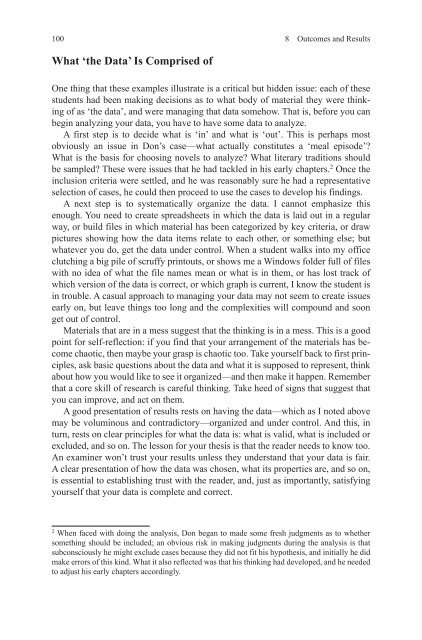How-to-Write-a-Better-Thesis
Create successful ePaper yourself
Turn your PDF publications into a flip-book with our unique Google optimized e-Paper software.
100 8 Outcomes and Results<br />
What ‘the Data’ Is Comprised of<br />
One thing that these examples illustrate is a critical but hidden issue: each of these<br />
students had been making decisions as <strong>to</strong> what body of material they were thinking<br />
of as ‘the data’, and were managing that data somehow. That is, before you can<br />
begin analyzing your data, you have <strong>to</strong> have some data <strong>to</strong> analyze.<br />
A first step is <strong>to</strong> decide what is ‘in’ and what is ‘out’. This is perhaps most<br />
obviously an issue in Don’s case—what actually constitutes a ‘meal episode’?<br />
What is the basis for choosing novels <strong>to</strong> analyze? What literary traditions should<br />
be sampled? These were issues that he had tackled in his early chapters. 2 Once the<br />
inclusion criteria were settled, and he was reasonably sure he had a representative<br />
selection of cases, he could then proceed <strong>to</strong> use the cases <strong>to</strong> develop his findings.<br />
A next step is <strong>to</strong> systematically organize the data. I cannot emphasize this<br />
enough. You need <strong>to</strong> create spreadsheets in which the data is laid out in a regular<br />
way, or build files in which material has been categorized by key criteria, or draw<br />
pictures showing how the data items relate <strong>to</strong> each other, or something else; but<br />
whatever you do, get the data under control. When a student walks in<strong>to</strong> my office<br />
clutching a big pile of scruffy prin<strong>to</strong>uts, or shows me a Windows folder full of files<br />
with no idea of what the file names mean or what is in them, or has lost track of<br />
which version of the data is correct, or which graph is current, I know the student is<br />
in trouble. A casual approach <strong>to</strong> managing your data may not seem <strong>to</strong> create issues<br />
early on, but leave things <strong>to</strong>o long and the complexities will compound and soon<br />
get out of control.<br />
Materials that are in a mess suggest that the thinking is in a mess. This is a good<br />
point for self-reflection: if you find that your arrangement of the materials has become<br />
chaotic, then maybe your grasp is chaotic <strong>to</strong>o. Take yourself back <strong>to</strong> first principles,<br />
ask basic questions about the data and what it is supposed <strong>to</strong> represent, think<br />
about how you would like <strong>to</strong> see it organized—and then make it happen. Remember<br />
that a core skill of research is careful thinking. Take heed of signs that suggest that<br />
you can improve, and act on them.<br />
A good presentation of results rests on having the data—which as I noted above<br />
may be voluminous and contradic<strong>to</strong>ry—organized and under control. And this, in<br />
turn, rests on clear principles for what the data is: what is valid, what is included or<br />
excluded, and so on. The lesson for your thesis is that the reader needs <strong>to</strong> know <strong>to</strong>o.<br />
An examiner won’t trust your results unless they understand that your data is fair.<br />
A clear presentation of how the data was chosen, what its properties are, and so on,<br />
is essential <strong>to</strong> establishing trust with the reader, and, just as importantly, satisfying<br />
yourself that your data is complete and correct.<br />
2<br />
When faced with doing the analysis, Don began <strong>to</strong> made some fresh judgments as <strong>to</strong> whether<br />
something should be included; an obvious risk in making judgments during the analysis is that<br />
subconsciously he might exclude cases because they did not fit his hypothesis, and initially he did<br />
make errors of this kind. What it also reflected was that his thinking had developed, and he needed<br />
<strong>to</strong> adjust his early chapters accordingly.














![[Lonely Planet] Sri Lanka](https://img.yumpu.com/59845622/1/169x260/lonely-planet-sri-lanka.jpg?quality=85)


